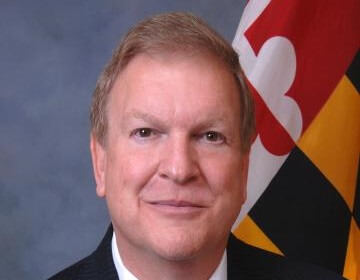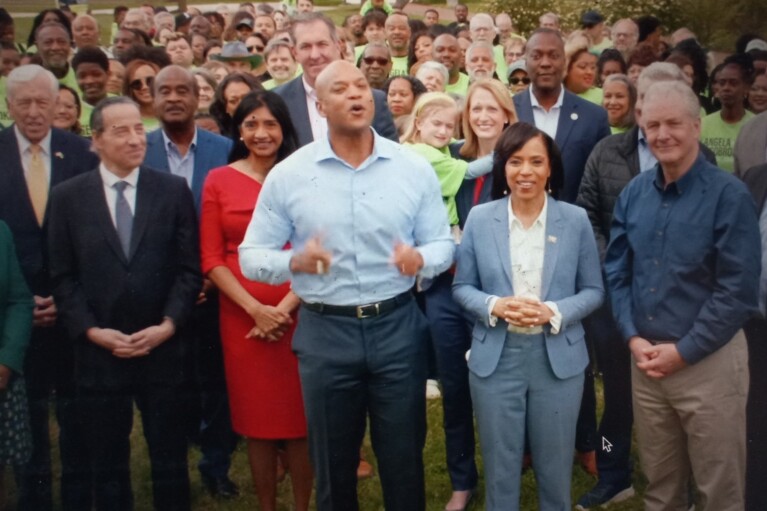State Assembles ‘Transit Work Group’ to Help Craft D.C.-Area Traffic Solutions

Faced with persistent criticism that the state is focusing too much on traffic relief and not enough on improving rail and bus opportunities, Maryland Transportation Secretary Pete K. Rahn on Friday met with members of a newly-formed “transit work group.”
The group, made up of representatives from county governments in the capital region, the Washington-area Metro system and others, “will explore how managed lanes on I-495 and I-270 will complement and benefit local transit agencies in Frederick, Montgomery and Prince George’s counties and Washington, D.C.,” according to a Maryland Department of Transportation (MDOT) news release.
The state is pushing ahead with plans, announced by Gov. Lawrence J. Hogan Jr. (R) in 2017, to widen Interstate 270 and the Capital Beltway (I-495) two lanes in each direction. The new “express toll” lanes (“managed toll lanes” in state parlance) would be funded and built by private sector firms that would have the right to set and collect tolls on them for 50 years or more.
Existing lanes would continue to be available free of charge, with the firms picking up future maintenance expense.
“Throughout public workshops and meetings with stakeholders about the Managed Lanes Study, residents and officials made clear they wanted us to consider more transit options,” said State Highway Administrator Greg Slater in the news release.
“We heard you and are committed to having transit providers at the table as part of the dialogue.”
“While we regularly partner with agencies in the region, this work group gives us a great opportunity to collaborate on ways to integrate better access to transit and improvements to transit into a managed lane project,” added Maryland Transit Administrator Kevin Quinn.
“Integrating transit opportunities into highway projects is key to meeting the comprehensive needs of the region.”
Rahn’s decision to form a “transit work group” follows weeks of criticism from local leaders, transit advocates and citizens.
They have faulted the state for relying too much on highways and not enough on transit when pondering ways to ease traffic congestion in the D.C. area, for not engaging local leaders or planners, and for insisting on a “public-private partnership.”
Montgomery County leaders — the Council and Executive Marc B. Elrich (D) — elevated their concerns in recent days with letters to the county Planning Board, urging the panel not to make “any” land available to the state unless a series of conditions were met first.
Among the conditions: a full-environmental review of the state’s plans and an “independent” assessment of the financial soundness of the so-called “P3” process Maryland intends to use.
Elrich on Friday called Rahn’s decision to create a transit working group “a start.”
“I wish this had been the place where the whole thing started,” he said. “I’m glad that we’ve arrived here and I just hope they recognize that we all share an interest in improving how the whole of our transportation system functions.”
In an interview with Maryland Matters earlier Friday, before MDOT announced its workgroup, Elrich repeated his belief that the state could greatly relieve traffic on 270 relatively inexpensively, by re-striping the lanes and adding a high-occupancy-vehicle lane.
“That absolutely would impact traffic on I-270 today,” he said. “I know it’s not big and sexy, but there are things they can do like that.”
Hogan’s plan to widen I-270, I-495 and the Baltimore-Washington Parkway (which is currently owned by the federal government) is estimated to cost $9 billion to $11 billion, making it potentially the largest P3 project in U.S. history.
Del. Marc Korman (D-Montgomery), a leading critic of the state’s plans and a member of the legislature’s transit caucus, praised Rahn for consulting with transit leaders, but he said the panel’s true value can’t be known until the state assesses its recommendations.
A recent town hall meeting on the highway expansion projects in Silver Spring drew a standing-room-only crowd of approximately 700 people – most of whom were opposed to the Hogan plan. And a Washington Post survey found both support for the Hogan administration’s plan but also concern that express toll lanes will take too many homes, cost too much and not solve the region’s traffic woes.
“I think they’re recognizing that they have a problem, and that’s good,” Korman said. “That’s what they’re supposed to do. We’ll just see if this is really a course correction.”
He said Maryland leaders need not look far if they want to see a way make life better for commuters of all stripes.
“If you want to see a way that a toll road and transit can go hand in hand, you need to look no further than the Dulles Toll Road, where the tolls from the Dulles Toll Road support the construction of [Metro’s] Silver Line,” Korman said.
“So there is clearly a way to integrate transit and roads.”
But he expressed concern that commuter buses will get caught in traffic on arterial roads like Georgia Avenue and Connecticut Avenue unless the state opts for what he called “bus priority.”
Roger Berliner, a former Montgomery Councilmember and Council of Governments president, expressed cautious optimism that the state is sincere about boosting the involvement of local leaders and “elevating” the use of transit.
“It should have been sooner,” he said. “This project has been under way for more than a year and up until now there have not been serious conversations with local governments.”
He accused Hogan, who tweeted at the town hall as it was happening, of being “quite derogatory” in his comments.
“They need to take the concerns of the communities most affected seriously, work with us on protecting neighborhoods, work with us on raising the profile of transit in this project — and being a partner, not a dictator,” said Berliner, who is now managing partner of DMV Strategic Advisors, a consulting firm.
Joining Rahn, Slater and Quinn at MDOT headquarters on Friday:
- Paul Wiedefeld, general manager and chief executive officer of the Washington Metropolitan Area Transit Authority;
- Al Roshdieh, director of the Montgomery County Department of Transportation;
- Terry Bellamy, director of the Prince George’s County Department of Public Works and Transportation;
- Nancy Norris, director of Frederick County TransIT Services;
- Gregory Murrill, division administrator of the Federal Highway Administration;
- Ryan Long, community planner of the U.S. Department of Transportation Federal Transit Administration’s Office of Planning & Program Development;
- Pat Keller, assistant secretary of the Maryland Department of Planning; and
- Metropolitan Washington Council of Governments representatives.
“I’m very grateful that transit is being considered,” Roshdieh said in the state’s news release. “We’ll certainly participate in the work group and hopefully come up with some solutions.”
Also in the news release, Wiedefeld is quoted as saying, “I really appreciate the effort of Secretary Rahn for bringing this group around the table to collaborate on this important effort of how transit can take advantage of managed lanes on I-495 and I-270.”




 Creative Commons Attribution
Creative Commons Attribution